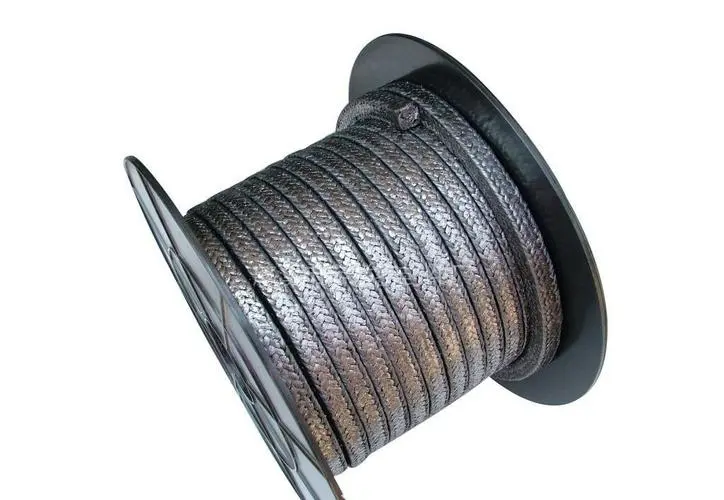Products for dynamic sealing under high temperature and pressure conditions
Graphite packing is mainly finely woven from various reinforced fibers, metal wires (steel wire, copper wire, nickel wire, carbon fiber, pre oxidized wire, glass yarn), and other reinforced graphite wires as raw materials. Suitable for dynamic sealing under high temperature and pressure conditions. Except for a few strong oxidizing agents, it can be used to seal hot water, superheated steam, heat transfer fluids, ammonia solutions, hydrocarbons, low-temperature liquids, and other media. It is mainly used for sealing valves, pumps, and reactors in high-temperature, high-pressure, and corrosion-resistant media. It is also a unique universal sealing packing.
Chinese name graphite packing graphite packing 3 × 3mm -50 × 50mmPh value (PH range) 2-12 Linear speed 0-15 meters/second m/s

technical parameter
Packing product specifications:
;
Pressure rotary pump 200bar reciprocating pump 100bar valve 400bar
Temperature -100~800 ℃
Product Application
Application devices
Pumps, valves, rotating machinery
Application industry
Chemical, petroleum, pharmaceutical, food and sugar, pulp, paper, and power industries.
Application Media
The chemical industry can tolerate media such as boric acid, dichloromethane, acetone, and glacial acetic acid. Graphite discs eliminate sealed hot water, high-temperature, high-pressure steam, heat exchange media, hydrogen, ammonia, organic solvents, hydrocarbons, low-temperature liquids, and other media outside of a few strong oxidizing media
type
1. Dense crystalline graphite packing
Dense crystalline graphite, also known as block graphite. This type of graphite crystal is clearly visible to the naked eye. The particle diameter is greater than 0.1 millimeters, and the specific surface area is concentrated in the range of 0.1-1m2/g. The crystal arrangement is disorderly and presents a dense block like structure. The characteristic of this type of graphite is its high grade, with a general carbon content of 60-65% and sometimes up to 80-98%. However, its plasticity and smoothness are not as good as those of flake graphite.
2. Flake graphite packing, flake graphite packing
The graphite packing crystal is in the form of scales; This is metamorphosed under high intensity pressure and can be divided into large scales and fine scales. The characteristic of this type of graphite ore is its low grade, usually between 2-3% or 10-25%. It is one of the best floatable ores in nature, and after multiple grinding and selection, high-grade graphite concentrate can be obtained. This type of graphite has superior floatability, lubricity, and plasticity compared to other types of graphite; Therefore, it has the greatest industrial value.
3. Cryptocrystalline graphite and cryptocrystalline graphite packing
Hidden quality graphite, also known as amorphous graphite or earthy graphite, has a crystal diameter generally less than 1 micrometer and a specific surface area range of 1-5m2/g. It is an aggregation of microcrystalline graphite and its crystal form can only be seen under an electron microscope. The characteristic of this type of graphite is that its surface is earthy, lacks luster, and has poor lubricity. High grade. Generally 60-80%. A few reach over 90%. Poor ore washability.
Graphite is widely used in industry, almost every industry uses it. Artificial graphite, also known as special graphite, is commonly used in industry. According to its molding methods, it can be divided into the following types.
(1) Isostatic pressing graphite. That is what many people call three high graphite, but it is not either three high or isostatic pressure.
(2) Molded graphite
(3) Extruded graphite, mostly made of electrode material.
According to the particle size of graphite, it can also be divided into: fine-grained graphite, medium coarse graphite, and electrode graphite.
Main purpose
Asbestos packing is used for weak acid and alkali, liquid ammonia, water, oil media, valves, and static sealing with the best anti-corrosion sealing effect. Fiber packing is a type of pump, valve, and reactor seal with good thermal conductivity, acid and alkali resistance, suitable for various solvents, gasoline, water, and liquid nitrogen media (another type of thermal conductivity, acid and alkali resistance, high temperature resistance, suitable for dynamic and static sealing under high-speed operating conditions). PTFE packing is made from pure PTFE dispersed resin as raw material, first made into raw material film, then twisted and woven into packing. This type of polytetrafluoroethylene has no other additives and can be widely used in food, pharmaceuticals, papermaking, chemical fibers, and other valves with high cleanliness requirements and strong corrosive media. It is not suitable for use on water pumps.
Aramid packing has excellent high rotational speed and high modulus properties (known as artificial metal wire). Its strength is three times that of metal wire and its weight is five times lighter than that of metal wire. Therefore, compared with other types of packing, it can resist particle crystallization media and higher temperatures, and can be used alone or in combination with other packing. It is suitable for wear prone media containing solid particles and is recommended for use in superheated steam, solvents, liquefied gas, syrup, and other easily worn fluids. It is a good substitute for asbestos in pump systems.
The high water based disc root is made of high-quality ramie fiber, coated with graphite inside and outside, and fully soaked in special lubricating oil, woven into a square shape. The outstanding advantages are extremely low friction coefficient, non grinding of the shaft, and anti-corrosion. Can be applied to the shipbuilding industry, cold water treatment, seawater, and cold oil; Low pressure valves, rotating equipment, and reciprocating pump hydraulic presses, ship propellers and other equipment. Recommended for use on general dynamic seals, low-pressure valves, rotating equipment, and reciprocating pumps. Temperature ≤ 140 ℃ pH value: 2-12 Linear speed: 10m/s blower 15bar mixer: 15bar valve: 20bar Suitable for various media such as water quality, seawater, saline water, oil, lipids, weak acids, weak alkalis, etc., especially resistant to grinding. (This packing is divided into black and white by color).
Graphite packing is a continuation of solid-phase carbonization reaction, where almost all non carbon elements, mainly nitrogen, in the carbon fiber are overflowed, resulting in graphite fibers with a carbon content close to 100%. The release of nitrogen is the result of further condensation reactions on small hexagonal carbon mesh planes, and solid-state graphitization condensation reactions may occur. Approximately 6% to 7% of nitrogen is removed during the graphitization process, leaving behind many pore defects and pores in the overflow path, resulting in the peak porosity Vp during the graphitization process. It can be seen that at around 2200 ℃, almost all nitrogen is removed, resulting in a decrease in porosity; After 2200 ℃, the porosity Vp decreases sharply and the density increases sharply. The condensation denitrification reaction of small aromatic rings is the main reaction in the graphite packing process, bringing significant changes to the elemental composition, porosity, and density of the fibers.









